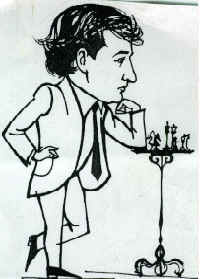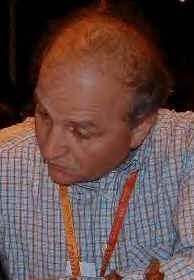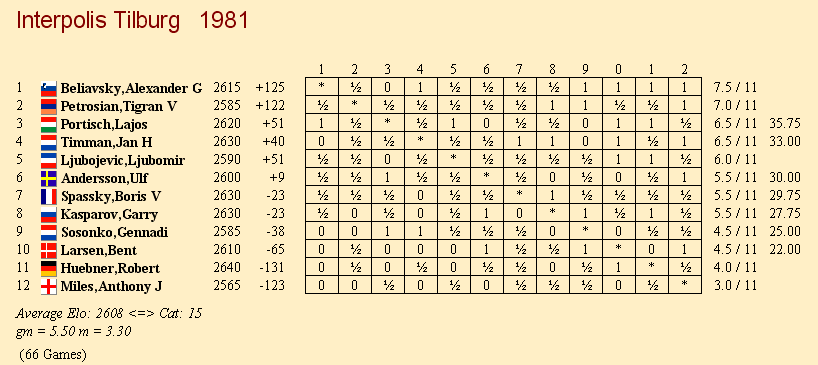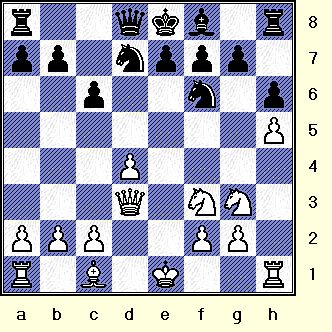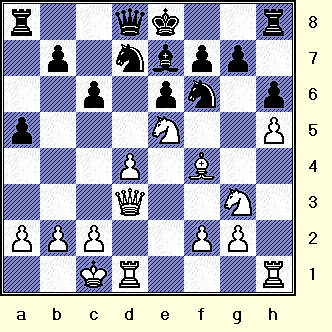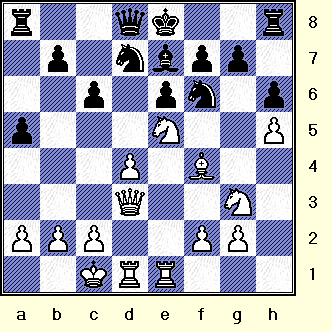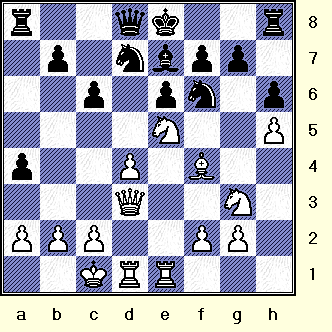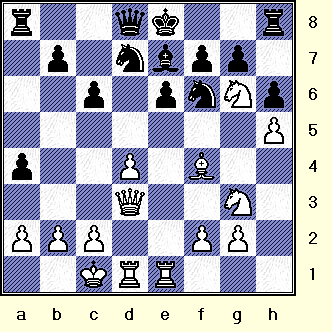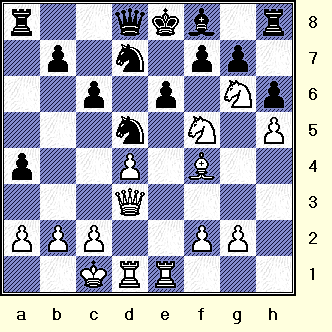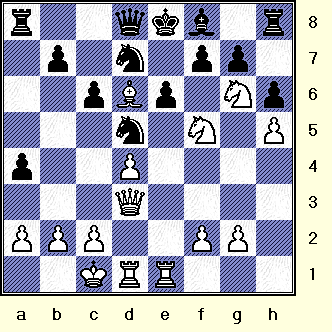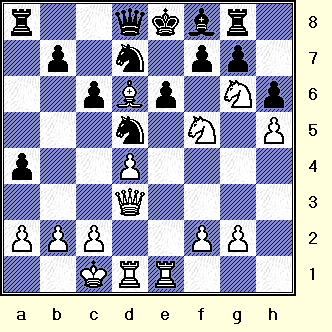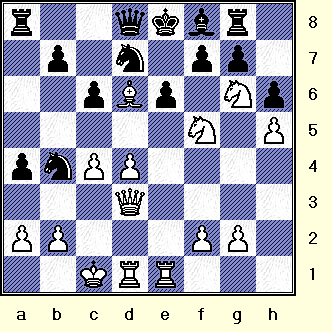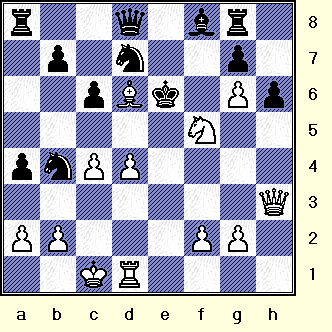All
the |
(Navigation bar
directly below.)
*******
© A.J. Goldsby, 2015.
(All rights reserved.)
****************
Click HERE
to see my
Chess Items.
****************
****************
Buy a book
from Amazon.com
(And help me out as well!)
****************
Click HERE
...
to see a list of the businesses that help to sponsor all of
my chess efforts.
... Beliavsky's Gold Coin?
This is one of my favorite games, I have started to annotate it more times than I care to admit. (But I have always gotten sidetracked by other things.)
Then - while I was working on my column for another site - I decided that I had to finish this game ... as part of my tribute to a truly great player.
GM Alexander Beliavsky ... has long been one of the world's best players. He won a World Junior Championship in 1973 and then tied for first (with TAL) at the 1974 USSR Championships. (Leningrad) He has (almost) won more tournaments than I can count, and he has also participated in the FIDE Candidates cycle numerous times. [more] While perhaps he is past his peak, he remains a respected competitor and chess teacher.
Now take a look at the image (cross-table) below.
Just about everyone in this event is a chess legend, note that way down the cross-table, a young Garry Kasparov was working hard ... just to finish at fifty per cent. Beliavsky won clear first, and only lost one game ... to the ever dangerous GM L. Portisch. I have studied just about all of his games from this event, he played some stellar & entertaining chess.
The contest below ... is from this tournament.
Click HERE to see an explanation of the symbols that I use when annotating a chess game. [replay]
GM Alexander Beliavsky (2615) -
GM Bent Larsen (2610)
|
|
|
[A.J. Goldsby I]
This could be one of GM A. Beliavsky's greatest games, it is also an example of his extraordinary ability to make the chess pieces do something special.
I also bring a unique insight into this clash, as I have studied it repeatedly over the years. (I also have shown it
to many friends and students over a 20+ year time span.)
You might want to buckle up ... this is going to be one heck of a ride!!!
** ** ** ** ** ** ** ** ** ** ** ** ** ** ** ** ** ** ** ** ** ** ** ** ** ** ** ** ** ** ** ** ** ** ** ** ** ** ** ** ** **
{The ratings are those of FIDE, and were assigned to this game in the ChessBase
database.}
1.e4,
Beliavsky uses many different openings.
[ For another example of Beliavsky's superb skill when on the offensive,
see the following encounter. (This time with 1.d4.)
After the moves:
1.d4 d5; 2.c4 c6;
3.Nf3 Nf6; 4.Nc3 e6; 5.Bg5,
{Diag?}
White won an exceptional game ... but it took 51 hard-fought moves.
GM Alexander G. Beliavsky (2618) - GM Suat Atalik (2598);
[D43]
The Yugoslav Champ.
(YUG-chT) / Vrnjacka Banja, Serbia &
Montenegro;
/ (R#8), 25,08,1999.
If you happen to have the "MEGA" database, this game is deeply and thoroughly annotated. ]
1...c6;
The Caro-Kann Defense.
Larsen has used this opening many times.
For example, see the contest: GM Boris Spassky (2640) - GM Bent Larsen (2620) / [B16] / ICT, Clarin Masters {Inv.} / Buenos Aires, ARG; (R7) / 1979. {Black won a crisp game, 0-1 in 39 total moves.}
2.d4 d5;
(Strategic concept?)
The basic idea of the Caro-Kann is actually similar to that of the French Defense, Black allows White to set up a pawn duo in the center ... and then proceeds to counter-attack it.
3.Nc3 dxe4;
4.Nxe4 Bf5;
This is the Classical Variation, it has been played by many GM's and even World Champions.
(E.g., Capablanca and Botvinnik.)
[ Today the following continuation is probably Black's most popular choice:
4...Nd7; ('!')
{delayed dev.}
This is the more modern line.
5.Nf3 Ngf6; 6.Nxf6+ Nxf6;
gives both sides a playable game.
An interest (recent) example was: FM Alexander Lukjanenko (2388) - GM Alexander Galkin (2599);
/
[B17]
/ National Tournament Championships,
(TCh-RUS) / Sochi, RUS; (R10) / 28,04,2005.
{White won a nice game, 1-0, in only 23 total moves, which is yet another
miniature.}
]
What follows now has long been a part of standard opening theory.
5.Ng3 Bg6;
6.h4 h6;
7.Nf3 Nd7; 8.h5 Bh7;
9.Bd3 Bxd3; 10.Qxd3 Ngf6!?;
{See
the diagram given - just below.}
So far, we have a 'book' line.
(Both sides keep an eye on the center, while continuing to develop their pieces.)
*****************************************
|
|
*****************************************
r2qkb1r/pp1nppp1/2p2n1p/7P/3P4/3Q1NN1/PPP2PP1/R1B1K2R w
10...Qc7; is often played here, but the lines can easily transpose into one another.
[ After the following moves:
10...Qc7; 11.Bd2 e6;
12.0-0-0 Ngf6; 13.Ne4 0-0-0;
14.g3,
we have just transposed into the note after White's eleventh move of Bf4.
]
11.Bf4,
('!?')
A modern continuation, Bd2 is the more often played line here.
[ The most common way of handling this position would have to be:
11.Bd2 e6; 12.0-0-0 Qc7;
13.Ne4 0-0-0; 14.g3,
"+/=" {Diag?}
White has a slight advantage, and went on to win a model game. (1-0, 61 moves.)
GM S. Karjakin - GM K. Asrian; 6th EICC / Warsaw, POL; 2005.
[ See also the reference work: MCO-14, page # 170; column # 01, & all relevant notes. ] ]
11...e6!?;
hmmm (OK ......)
An extremely sharp line.
At one time, it was a given that both sides would castle Queen-side in this particular variation.
But today, modern masters often prefer to castle on the King-side, when both parties go "all-out" to bust
up their opponent's King position.
Almost needless to say ... this leads to some very interesting chess.
[ By playing the continuation:
11...Qa5+; ('!')
12.Bd2 Qc7;
Black can transpose back to the more common ('book') lines.
]
12.0-0-0 Be7;
Both sides have nearly completed their development. White is slightly better, he has already castled and the first player has more space.
13.Ne5,
(Maybe - '!')
To me - this is the most natural (and forceful) move that White can play in this position.
However, theory sees no clear-cut consensus about which play is White's absolute best here.
(Many different moves have been tried, to include 13.Kb1!? and also 13.Rhe1 as well.)
[ White can also play:
13.Rhe1!? a5; 14.c4 b5!;
15.c5!? Nd5; 16.Be5 0-0; 17.Ne4 N7f6;
18.Nxf6+ Nxf6;
19.Bxf6 Bxf6; 20.g4 Qd5; 21.Kb1 Rfd8;
"~" (Maybe "=/+")
"Black has the better chances."
- GM Alexei Suetin.
GM M. Tal - GM B. Larsen;
ICT, Masters / Tilburg,
NED; 1980.
(1/2, 37 moves.)
{This game was eventually drawn, although Larsen might have missed a few opportunities.}
See the book: "The Caro-Kann Defense,"
by GM Alexei Suetin.
Copyright (c) 1983, (by the author). Revised, translated into English, and typeset by
Sportsverlag, in 1988. Published in the USA, by Batsford Books, Ltd. (London, ENG.)
ISBN: # 0-7134-5939-5
(See Chapter Two, 4...Bf5. Line # 2B2d, page # 61.) ]
13...a5;
('!?') {Premature?}
{See
the diagram given - just below.}
Larsen has always played risky chess, getting his King out of the center was far wiser.
[But I should note that several books - on this opening - award this play an exclam ('!') here.]
Black should have castled ... or possibly tried Fritz's suggestion of playing
13...Nd5 here.
(Either move would have prevented the catastrophe that befalls Black in this game.)
*****************************************
|
|
*****************************************
r2qk2r/1p1nbpp1/2p1pn1p/p3N2P/3P1B2/3Q2N1/PPP2PP1/2KR3R w
A critical position has been reached ... how should White proceed from here?
[ Black should have played the following continuation here:
>/= 13...0-0; 14.Kb1 Qa5;
15.Ne4, "+/=" (space)
{Diagram?}
and the first party has a slight advantage ... more elbow room and good piece activity.
GM V. Topalov - GM E. Bareev; FIDE Candidates
Semi-Final, (sf2) / Dortmund, GER; 2002.
{Black won a long game
/ {at the Sparkassen} ... but the opening was definitely not at fault here!}
]
14.Rhe1!?,
(Maybe - '!') {See
the diagram given - just below.}
The simplest and most logical, White masses in the center. (Although if Black had castled, maybe e1 would
not have been the best square for the White Rook.)
*****************************************
|
|
*****************************************
r2qk2r/1p1nbpp1/2p1pn1p/p3N2P/3P1B2/3Q2N1/PPP2PP1/2KRR3 b
The tension is reaching a fever pitch.
[ For whatever reason, Fritz 8.0 (after about 20 minutes), greatly prefers
the following try: 14.Ne2!?,
"+/=" but I was never able to work out a
variation that was convincing.
]
14...a4?!;
('?' - many authors) {See
the diagram given - just below.}
This is now doubtful, the Black King is not safe in the center.
*****************************************
|
|
*****************************************
r2qk2r/1p1nbpp1/2p1pn1p/4N2P/p2P1B2/3Q2N1/PPP2PP1/2KRR3 w
Black's concept is based on the idea that if White plays cautiously, (say with 15.a3); Black plays the simple move, 15...Nb6; with an excellent game.
But ... can you guess what White's next move will be? (It is White's turn to play and make his 15th move.)
15.Ng6!!,
(Maybe - '!!!') {See
the diagram given - just below.}
A powerful blow ... that takes imagination, courage, and steel nerves to play.
(Especially when your opponent is already a real legend in the world of chess!)
*****************************************
|
|
*****************************************
r2qk2r/1p1nbpp1/2p1pnNp/7P/p2P1B2/3Q2N1/PPP2PP1/2KRR3 b
Now Black finds himself in a real dilemma, and must answer the question, "To take ... or not to take?"
[ Fritz (6.0) wants to play:
(</=) 15.Nxd7 Qxd7;
16.Be5, ("+/=")
but this is hardly as
convincing as the continuation that Beliavsky has chosen here.
]
15...Nd5; ('!?')
(counterplay?)
Its hard for me to be too critical of this move, Black may already be lost. And it is part of Larsen's style not to staunchly defend, but he often will counter-attack ... whether the position calls for it ... or not.
I have also analyzed this position out to a forced win ... ... ...
no matter what Black plays. So I am not sure if it is scientifically correct to critique a move ...
when there is no salvation in any of the alternatives. (One has to go back earlier in the game.)
[ After the "obvious" continuation, (which some pundits have stated was much better than the game):
15...fxg6!?; 16.Qxg6+ Kf8;
17.Rxe6 Qe8; 18.Nf5!,
"~"
White has a very powerful attack. ("--->")
(Fritz 8.0 gives a "plus-over-a-line" here {'±'}. "+1.23," after over 30 minutes of machine time.
After several days of work ... I don't think that Black has a realistic hope of saving this position.)
And ... just for the record ... GM A. Beliavsky gives this play, (15...fxg6?) a full question mark!
( For the record, I give the main line of Beliavsky's analysis:
(</=)
18.Rde1!? Qxg6; 19.hxg6 Bb4;
This could be forced.
( </= 19...Re8?; 20.Rxe7! Rxe7; 21.Bd6 Nd5; 22.Nf5, ("+/-") {A.J.G.} )
20.c3 Nd5; 21.Bd2 Ba5;
22.c4! Bxd2+; 23.Kxd2 N5f6;
24.Re7, "+/-" {Dg?}
GM A. Beliavsky ends (his line) here, and concludes that White is winning pretty easily.
Fritz 9 concurs with this, providing an evaluation of "+/-" and "+6.17."
(Which I would say is pretty much conclusive.)
)
************************************************************************************************************
Several illustrious annotators - to include Beliavsky - have all said that
15...a3; ('!') would
have saved Black, {or
at least been an improvement over the game}; but this is not correct.
Once more, we follow the main line of Beliavsky's analysis, (the sidelines are my own work).
15...a3!;
Beliavsky awards this an exclam, but it might deserve a dubious appellation instead.
16.b3!,
This is definitely best, if Black opens lines to the White King, it gains the second party
much needed counterplay.
( (</=) 16.Nxh8!? axb2+; 17.Kb1 Ra3!; "<=>" )
16...Nd5!?,
(Maybe - '!')
Black may be forced into trying this, most of the alternatives are grossly inferior.
( Probably inferior would be:
</= 16...fxg6?!; 17.Qxg6+ Kf8;
18.Rxe6 Qe8; 19.Nf5 Nxh5;
20.Qxe8+ Rxe8;
21.Rxe7 Nxf4;
22.Rxd7 g6; 23.Ne3 Re7;
24.Rxe7 Kxe7; 25.Re1, '±' {D?}
Fritz considers this a win for White. ("+1.67") )
17.Nf5!! exf5; 18.Nxe7 Nxe7;
19.Bd6 Ne5[]; 20.dxe5 0-0!?;
This is possibly less than best.
21.e6,
"+/-" {Diagram?}
Beliavsky awards a "plus-over-a-line" here, but Fritz 9 shows that White is winning
by over two whole points here.
]
16.Nf5!!,
(Yowzers!)
Another powerful and crushing blow, Beliavsky refuses to yield the initiative.
[ A lot less convincing was:
</= 16.Nxh8!? Nxf4; 17.Qf3 Bg5;
And while this line is probably winning
("+/-") for White, but might
allow more counterplay than Beliavsky's artful attack.
]
16...Bf8[];
(Box?) {See
the diagram given - just below.}
Now this is probably forced for Black. (Other moves are worse, some lose horribly for Larsen.)
*****************************************
|
|
*****************************************
r2qkb1r/1p1n1pp1/2p1p1Np/3n1N1P/p2P1B2/3Q4/PPP2PP1/2KRR3 w
Black looks to be holding ... or is this all just a misconception?
[ </= 16...Nxf4?; ('??') 17.Nxg7#.
*********************************************************************
Also of no real help was: </=
16...fxg6?; 17.Nxg7+,
"+/-"
and it is mate in two - at most. (Work it out!)
*********************************************************************
Nor would the following continuation be any real improvement:
(</=)
16...exf5!?; ('?!')
17.Nxe7 Nxe7; 18.Bd6 Ne5,
(Forced.)
19.dxe5, ("+/")
Fritz consider this position to be a win for White.
]
Now - how does White proceed from here?
17.Bd6!,
(thematic) {See
the diagram given - just below.}
Rather than win material, Beliavsky continues his assault, and draws the noose tighter around Larsen's King.
*****************************************
|
|
*****************************************
r2qkb1r/1p1n1pp1/2pBp1Np/3n1N1P/p2P4/3Q4/PPP2PP1/2KRR3 b
Note that the d6-squre is often a big problem for Black in many lines of the Caro-Kann Defence.
[ The play of: </= 17.Nxh8!?, '±' also gives White a good game. ]
17...Rg8[];
(100% forced.) {See
the diagram given - just below.}
Absolutely no choice here for Black.
(Unless he would rather drop a Rook ... or maybe he should just consider resignation already?)
*****************************************
|
|
*****************************************
r2qkbr1/1p1n1pp1/2pBp1Np/3n1N1P/p2P4/3Q4/PPP2PP1/2KRR3 w
White obviously has his opponent in a tremendous bind, but what is the correct method of execution?
18.c4!!,
(Shock and awe!!!)
(today) Beliavsky drinks out of the same cup as Tal, this is truly an inspired move. (Some writers have criticized this play, but their notes are insipid and their analysis is just plain shoddy.)
[ Beliavsky could have (also) tried:
(</=) 18.Nxf8 Nxf8; 19.Bg3!? Qg5+;
20.Kb1 Nd7; 21.Nd6+ Kf8;
22.Qe2!,
'±' (Maybe "+/-")
and while this line is also winning
for
White, it can hardly be called awe-inspiring.
]
18...Nb4;
(hmmm) {The best?}
{See
the diagram given - just below.}
While some criticized Black's defense in this game, this move is nearly forced. Larsen's defensive strategy here is very tricky ... and is laden with landmines.
*****************************************
|
|
*****************************************
r2qkbr1/1p1n1pp1/2pBp1Np/5N1P/pnPP4/3Q4/PP3PP1/2KRR3 w
Now almost no one that I have ever studied this game with has found the correct continuation from here.
(Try it out on your friends, and see for yourself!!!)
[ The following continuation:
(</=) 18...N5b6!?; 19.d5 Nc5;
20.Qg3, ("+/-") {Diag?}
can hardly be considered any improvement. (White should have no real problems
winning from here.) ]
White to move ... what move would YOU play in this position?
19.Qh3!!,
(Why is this correct?)
I have tested this position on MANY strong (1800+) players, none have ever guessed the complete line of play here. (Beliavsky is about to sacrifice a Rook ... to force an original and ingenious mate, right in the middle of the board!)
[ Less convincing would have been:
</= 19.Qg3 ('!?')
19...Qf6; ('!') -
A. Beliavsky.
(Black gains a measure of counterplay.)
]
19...fxg6!?;
('?!' ... maybe - '?')
This loses badly.
Yet Larsen later wrote (in a Danish chess magazine) that he saw no harm in testing White's concept, as he had already seen a win for White in all variations.
[ Bent Larsen was the first to point out that after the simple moves in the following continuation:
(>/=)
19...Qa5; 20.Nxf8 Nxf8;
21.a3 Na6; 22.Bf4, "+/-"
{Diagram?}
that Black is losing. Further, Larsen has no hope of counterplay in this line, and this is
completely alien to his interpretation of playing ANY chess position!!
]
20.Rxe6+ Kf7;
(Ouch!)
This is forced, sticking a piece on e7 was ugly and suicidal.
[
After the following moves: </=
20...Be7?!, ('?')
21.Nxe7, "+/-"
and White is winning easily. (b4 and g8 all are hanging ...
and Fritz already sees a mate on the horizon, albeit - it is
more than 10 moves away.) ]
21.hxg6+!,
(Do you see it yet?)
Now Alexander willingly sacrifices a Rook to force the Black King further out into the open.
[ Beliavsky could have also tried:
</= 21.Ne7,
("+/-") {Diagram?}
This also wins ... but it is not as pretty as the game.
(This is the move
that my students will invariably choose in this position.)
]
21...Kxe6[];
{BOX!!}
{See
the diagram given - just below.}
Now ... this is the only legal move! (No thinking required.)
*****************************************
|
|
*****************************************
r2q1br1/1p1n2p1/2pBk1Pp/5N2/pnPP4/7Q/PP3PP1/2KR4 w
Now study this position carefully ...
White to play in this position, what is the correct way to finish Black off from here?
22.Re1+,
(Maybe - '!')
Now you would think that this is the only move that anyone would seriously consider. But when I have shown this position to (much) lower-rated players, they look at a number of different tries here.
(22.Kb1!?, 22.d5+?!, and also {the correct} 22.Re1+.)
[ Less effective was: </= 22.Kb1!?, but it is also still winning. ("+/-") ]
22...Ne5[];
Unfortunately for Black ... this is also forced.
(22...Kf6?; leads to a forced mate, see the note just below.)
[ After the following continuation:
(Or if: 25...Kxg6; then 26.Qf5#. Or 25...Qa5; 26.Re6+ Kg5;
27.f4#.)
26.f4+ Kf6;
27.Qf5#.
(Study the basic mating positions, see if you can 23.Bxe5!,
("+/-") Black
Resigns. (1-0)
[ After the following continuation:
23.Bxe5 Nd3+; Taking the WP on a2,
24.Kb1 Nxe5[];
Forced.
(</= 24...Nxe1?; 25.Nxg7+! Ke7; 26.Qe6#.)
25.Rxe5+ Kd7; 26.Nxg7+ Kc7;
27.Ne6+, ("+/-")
and White wins
*****************************************************************************************************
The following continuation:
It is - seemingly - the more natural continuation, and the one that my friends and
Perhaps Beliavsky's greatest game, it is - without question - a fantastic game of chess, and also one of my ***********************************************************************************************************
This game is annotated in many books. ***********************************************************************************************************
Copyright (c) A.J. Goldsby, 2006. All rights
reserved. The analysis for
this page was prepared with the excellent program,
ChessBase
9.0. The HTML was
polished with several different tools and programs, (mostly
FP) ... the text was checked for spelling
with MS Word. The diagrams
were created with the program, Chess
Captor 2.25.
</=
22...Kf6?!; ('?')
23.Ng3 Nxa2+;
24.Kb1 Nc3+; 25.Ka1! Kg5;
It does not matter
anymore.
categorize this particular set-up.)
]
(Larsen faces either a massive
loss of material or certain mate.)
(23.dxe5! also worked as well.)
Black Knight); will probably transpose into the note given after Black's last move.
(</=) 23.Rxe5+!? Kd7;
24.Nxg7+ Kxd6; 25.c5+ Kc7; 26.Ne6+ Kc8;
27.Nxd8+ Kxd8; 28.Qf5,
"+/-" still wins for White.
students invariably choose for White in this position. (Hence the exclam for 23.Bxe5!
And Fritz {also}
shows that taking with the Bishop IS superior to taking with the Rook
on move 23.) ]
favorites.
(For more information, or a more complete analysis, see {the}
Informant # 32, game # 198.)
1 - 0
Click HERE to - go to or return - to my HOME PAGE ... for this site.
Click HERE to go (or return) to my site map (page).
Click HERE to go (or return) to my page with chess miniatures. (More "shorts," Volume III.)
Click HERE to go (or return) to my "Annotated Games II" (page).
Click HERE
to - go to or return - to my {second} main page on miniatures /
or "Best Short
Games."
(Or you could use the "Back
Button" on your web browser.)
Copyright (c) LM A.J. Goldsby I
Copyright (©) A.J. Goldsby, 2011. All rights reserved.
*******
This page was first created in February, 2006. It was posted: 02/06/2006. It was last updated on: July 14, 2012 02:16 AM .
